Recent publications
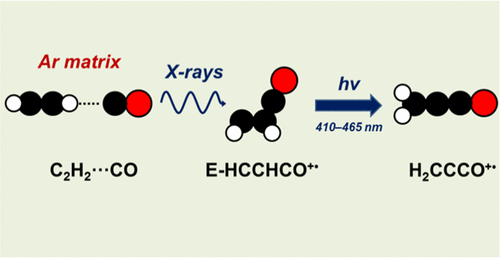
Pavel V. Zasimov, Daniil A. Tyurin, Sergey V. Ryazantsev, and Vladimir I. Feldman
Formation and Evolution of H2C3O+• Radical Cations: A Computational and Matrix Isolation Study
J. Am. Chem. Soc. 2022, 144, 18, 8115–8128
DOI: 10.1021/jacs.2c00295
Abstrct
The family of isomeric H2C3O+• radical cations is of great interest for physical organic chemistry and chemistry occurring in extraterrestrial media. In this work, we have experimentally examined a unique synthetic route to the generation of H2C3O+• from the C2H2···CO intermolecular complex and also considered the relative stability and monomolecular transformations of the H2C3O+• isomers through high-level ab initio calculations. The structures, energetics, harmonic frequencies, hyperfine coupling constants, and isomerization pathways for several of the most important H2C3O+• isomers were calculated at the UCCSD(T) level of theory. The complementary FTIR and EPR studies in argon matrices at 5 K have demonstrated that the ionized C2H2···CO complex transforms into the E-HCCHCO+• isomer, and this latter species is supposed to be the key intermediate in further chemical transformations, providing a remarkable piece of evidence for kinetic control in low-temperature chemistry. Photolysis of this species at λ = 410–465 nm results in its transformation to the thermodynamically most stable H2CCCO+• isomer. Possible implications of the results and potentiality of the proposed synthetic strategy to the preparation of highly reactive organic radical cations are discussed.

Alexey A. Zharikov, Elena A. Zezina, Rodion A. Vinogradov, Alexander S. Pozdnyakov, Vladimir I. Feldman, Sergey N. Chvalun, Alexander L. Vasiliev and Alexey A. Zezin
Assembling of Metal-Polymer Nanocomposites in Irradiated Solutions of 1-Vinyl-1,2,4-triazole and Au(III) Ions: Features of Polymerization and Nanoparticles Formation
Polymers 2022, 14(21), 4601; DOI: 10.3390/polym14214601
Abstract
Gold nanoparticles (AuNPs) stabilized with poly(1-vinyl-1,2,4-triazole) (PVT) have been synthesized via a one-pot manner in irradiated solutions of 1-vinyl-1,2,4-triazole (VT) and Au(III) ions. The transmission electron microscopy examinations have shown that the sizes of nanoparticles formed range from 1 to 11 nm and are affected by the ratio of VT to gold ions. To study the kinetics peculiarities of the VT polymerization and assembling of AuNPs, UV-Vis spectroscopy was used. The analysis of the data obtained reveals that an inhibition period, influenced by Au(III) concentration, is followed by the polymerization of a monomer. Importantly, the absorbed doses, corresponding to the onset of rapid polymerization, correlate with the doses at which the accelerated formation of AuNPs begins. The kinetics aspects, which could lead to such an effect, are discussed.

Vladimir D Drabkin, Anastasia D Volosatova, Vladimir I Feldman
Direct evidence for formation of acetimidic acid and acetamide under irradiation of isolated acetonitrile-water complexes at cryogenic temperatures
Monthly Notices of the Royal Astronomical Society, stac3067, DOI: 10.1093/mnras/stac3067
Abstract
In this work we report the first direct evidence for formation of the key simplest molecule with the peptide bond (acetamide) under radiation-induced transformations occurring in the CH3CN∙∙∙H2O complex isolated in an argon matrix at 6 K. The 1:1 CH3CN∙∙∙H2O intermolecular complex was obtained by deposition of CH3CN/H2O/Ar mixtures and characterized by FTIR spectroscopy. The irradiation of the icy matrix with X-rays results first in formation of acetimidic acid, which is transformed to acetamide at higher absorbed doses. In addition, the products of acetonitrile oxidation (hydroxyacetonitrile and acetonitrile N-oxide) have been detected, which probably originate from the reactions of “hot” radiation-induced oxygen atoms. The formation of acetamide was confirmed by deuterium isotopic substitution in acetonitrile. We believe that the observed transformation may be of basic importance for understanding the radiation-induced synthesis of prebiotic molecules in occurring in cold space media.
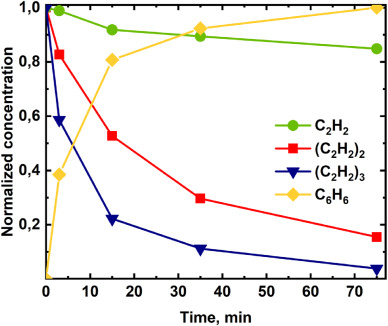
Mariia A.Lukianova and Vladimir I.Feldman
Direct evidence for a single-step radiation-induced assembling of benzene ring from acetylene trimer at cryogenic temperatures
Radiation Physics and Chemistry, 2021, 183,109417.
DOI: 10.1016/j.radphyschem.2021.109417
Abstract
The discovery of carbon-rich species, including polycyclic aromatic hydrocarbons (PAH) and fullerenes, in the space environment is among the most intriguing findings in molecular astrophysics and astrochemistry of the recent decades. The mechanism of their formation remains unclear and the one of the key issues is related to making “first ring”, i.e., formation of benzene from simple small molecules abundant in the outer space. Different routes involving C2, C3 and C4 hydrocarbons are considered in literature. Here we report the first direct evidence for a single-step radiation-induced formation of benzene from pre-existing isolated acetylene trimer occurring in frozen inert environment at very low temperature (6 K). The finding is based on the correlation between trimer decay and build-up of benzene as monitored by FTIR spectroscopy. This concerted pathway may be applicable to acetylene aggregates trapped in the bulky ices or in the grain pores and it emphasizes the importance of concept of molecular organization in the chemical history of the Universe.
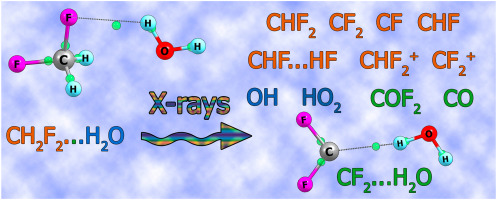
Ilya S.Sosulin and Vladimir I.Feldman.
Spectroscopy and radiation-induced chemistry of an atmospherically relevant CH2F2…H2O complex: Evidence for the formation of CF2…H2O complex as revealed by FTIR matrix isolation and ab initio study
Chemosphere, 291, 132967, 2022
DOI: 10.1016/j.chemosphere.2021.132967
Abstract
Difluoromethane is considered among the environment friendly alternatives to the ozone depleting chlorofluorocarbons. Due to its chemical inertness and lack of UV absorption above 200 nm, this compound can easily come to the upper layers forming complexes with widely abundant atmospheric components, such as water. The radiation-induced degradation of this compound and its complexes may be significant for reliable prediction of its long-term evolution in the environment as well as for development of new ways for its removal. In this work we have studied the vibrational spectroscopic properties and mechanisms of the radiation-induced decay of the CH2F2⋯H2O under the action of X-rays using matrix isolation FTIR spectroscopy and ab initio calculations. The IR spectrum of the complex in an argon matrix was characterized for the first time and assigned to a hydrogen-bonded structure with a binding energy of 11.1 kJ/mol (2.65 kcal/mol) (CCSD(T)/CBS level of theory). Complexation with water leads to a certain suppression of the efficiency of the radiation-induced decomposition of difluoromethane. The obtained results provide evidence for the radiation-induced formation of previously unreported CF2⋯H2O complex (in addition to other oxygen containing molecules, such as COF2 and CO). As demonstrated by calculations, the new difluorocarbene complex reveals a hydrogen bond and it is characterized by a binding energy of 5.73 kJ/mol (1.37 kcal/mol) (CCSD(T)/CBS level of theory).
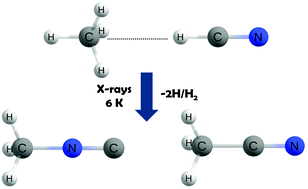
Anastasia D. Volosatova, Mariia A. Lukianova, Pavel V. Zasimov and Vladimir I. Feldman.
Direct evidence for a radiation-induced synthesis of acetonitrile and isoacetonitrile from a 1 : 1 CH4⋯HCN complex at cryogenic temperatures: is it a missing link between inorganic and prebiotic astrochemistry?
Phys. Chem. Chem. Phys., 23, 18449-18460, 2021.
DOI: 10.1039/D1CP01598B
Abstract
Nitriles are important constituents of extraterrestrial media. Nitriles are supposed to play a crucial role in prebiotic chemistry occurring in the interstellar medium. In this work, we have investigated the low-temperature radiation-induced transformations of a 1 : 1 CH4⋯HCN complex as a plausible precursor of the simplest nitriles using the matrix isolation approach with FTIR spectroscopic detection. The parent complexes isolated in a noble gas (Ng) matrix were obtained by deposition of the CH4/HCN/Ng gaseous mixture and characterized by comparison of experimental complexation-induced shifts of the HCN fundamentals with the results of the ab initio calculations. It was found that the X-ray irradiation of low-temperature matrices containing the isolated 1 : 1 CH4⋯HCN complex resulted in the formation of acetonitrile (CH3CN) and isoacetonitrile (CH3NC) and it appears to be the first experimental evidence for the formation of C2 nitriles (acetonitrile and isoacetonitrile) from such a “building block”. Additionally, a 1 : 1 CH4⋯HNC complex was tentatively assigned to the irradiated Ar and Kr matrices. It is demonstrated that the matrix has a strong effect on the CH3CN/CH3NC yield ratio, which dramatically increases in the row Ar < Kr < Xe. Also, the efficiency of the radiation-induced formation of the CH4⋯HNC complex was shown to decrease from Ar to Kr. It is believed that the proposed pathway for acetonitrile formation may be a significant step in the radiation-induced evolution leading to complex organic molecules and biomolecules under astrochemical conditions. Furthermore, the obtained results provide a prominent example of the impact of very weak intermolecular interactions on the radiation-induced transformations in cold media.
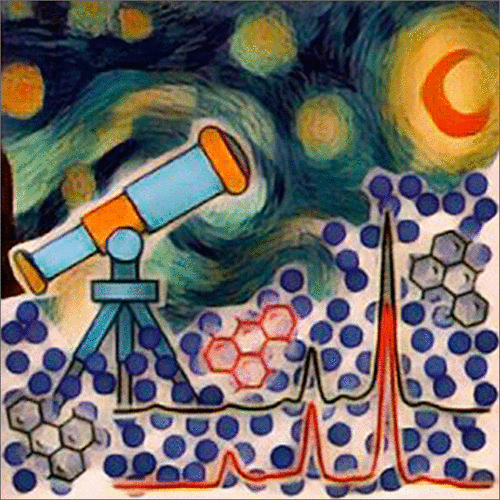
Feldman Vladimir I., Ryazantsev Sergey V., Kameneva Svetlana V.
MATRIX ISOLATION IN LABORATORY ASTROCHEMISTRY: STATE-OF-THE-ART, IMPLICATIONS AND PERSPECTIVE
RUSS CHEM REV, 90, 2021. DOI: 10.1070/RCR4995
Abstract
Recent progress in observational astronomy and astrophysics has stimulated the intensive laboratory studies aimed at elucidation of the mechanisms of evolution of molecular matter in interstellar space and various space objects. One of the most intriguing and rapidly developing areas of these studies is the so-called “cold astrochemistry” devoted to the complex processes occurring in astrophysical ices. In this context, the matrix isolation technique (known for decades) is a very useful approach for both interpretings the results of astrophysical observations and verifying possible mechanisms of key astrochemical processes. This review outlines the most important results of recent studies using matrix isolation technique, which contribute to the solution of the problems of “cold astrochemistry” in two main aspects: (i) spectroscopy of astrochemical important molecules, ions and radicals stabilized in cryogenic matrices; (ii) experimental modeling of mechanisms of radiation-induced and “in dark” chemical reactions occurring in “cold” space environments (interstellar, cometary and planetary ices). In the first aspect, special attention is paid to new spectroscopic data obtained using various methods (electronic and vibrational absorption spectroscopy, electronic paramagnetic resonance spectroscopy). In the second aspect, we consider the chemical effects resulting from both direct excitation of isolated molecules and the transfer of energy initially absorbed by the medium. Special attention is paid to recent studies of spectroscopic characteristics and radiation-induced evolution of matrix-isolated weak intermolecular complexes, which can be considered as “building blocks” for the cold synthesis of complex molecules in the absence of diffusion mobility. In addition, we consider the use of matrix isolation for the studies of low-temperature chemical reactions “in dark” involving atoms and highly reactive intermediates, which can occur in cold space environments. In the final part, we briefly discuss the applicability of the results of matrix isolation experiments for interpretation of the mechanisms in molecular ices and highlight the prospects of this field. The review can also be useful for the specialists in various aspects of chemistry and chemical physics (radiation chemistry, photochemistry, molecular spectroscopy, low-temperature chemistry). The bibliography includes 379 references.
Zasimov Pavel V., Ryazantsev Sergey V., Tyurin Daniil A., Feldman Vladimir I.
C2H2∙∙∙СO complex and its radiation-induced transformations: a building block for cold synthetic astrochemistry
MN RAS 2021 stab1820. DOI: 10.1093/mnras/stab1820
Abstract
In this work we have examined the radiation-induced synthetic chemistry occurring in an astrochemically important C2H2–CO system at the molecular level using a matrix isolation approach. The 1:1 C2H2∙∙∙CO intermolecular complex of linear structure was obtained in the solid low-temperature (5 K) noble gas matrices by deposition of the C2H2/CO/Ng (Ng = Ar, Kr, Xe) gaseous mixtures and characterized by Fourier-transform infrared (FTIR) spectroscopy. It was found that the X-ray radiolysis of the C2H2∙∙∙CO complex resulted in formation of C3O (tricarbon monoxide), HCCCHO (propynal), c-H2C3O (cyclopropenone), H2CCCO (propadienone), and HC3O (oxoprorynyl radical). This means that the studied complex may be considered as the simplest building block (or minimal size of intermolecular reactor) for cold astrochemistry occurring in mixed interstellar ices. Remarkably, the discovered transformations of the complex actually represent synthetic routes leading to various C3 species, whereas the acetylenic C–H bond cleavage yielding ethynyl radical appears to be a minor process. Prolonged irradiation results in dehydrogenation, while the C3 skeleton is retained. The interpretation of the C2H2∙∙∙CO radiolysis mechanism (possible reactions pathways) is provided based on the analysis of kinetic curves and matrix effect. Astrochemical implications of the results are discussed.
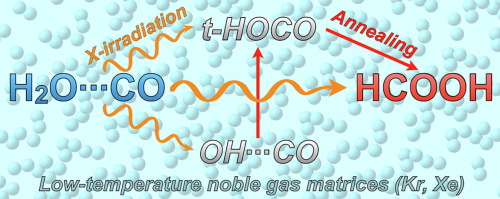
Sergey V.Ryazantsev, Pavel V.Zasimov, Vladimir I.Feldman
Radiation-induced synthesis of formic acid in the H2O–CO system: A matrix isolation study
Chem. Phys. Lett. 2020 753, 137540. DOI: 10.1016/j.cplett.2020.137540
Abstract
X-radiolysis of the noble-gas matrices containing both H2O and CO was investigated at 5 K using infrared spectroscopy. It was found that formic acid molecule (HCOOH) could be produced from the matrix-isolated H2O⋯CO complexes, either directly as a result of irradiation or upon the subsequent annealing activating the trans-HOCO + H reaction. The former way was observed in Kr, while the latter one in Xe matrix. Matrix-specific behavior and possible astrochemical implications are discussed.
Alexey A. Zezin, Dmitry I.Klimov, Elena A. Zezina, Kristina V. Mkrtchyan, Vladimir I.Feldman
Controlled radiation-chemical synthesis of metal polymer nanocomposites in the films of interpolyelectrolyte complexes: Principles, prospects and implications
Rad. Phys. Chem. 2020 169, 108076. DOI: 10.1016/j.radphyschem.2018.11.030
Abstract
The radiation-chemical synthesis of metal nanoparticles embedded into polymer matrices is an effective tool for preparation of the composite materials with very useful functional properties. This paper presents a review of an original approach to a single-step production of such materials via the radiation-induced reduction of the interpolyelectrolyte complex (IPEC) films containing metal ions under heterogeneous conditions, including the most recent results, and analysis of the prospects of this approach and its implications. First, the properties of IPECs as precursors for nanocomposites are briefly considered. Particular impact is given to the mechanistic aspects and principles of control of the nanoparticle formation and assembling at different stages. A common procedure of the radiation-chemical synthesis of metal polymer nanocomposites in the IPEC matrices implies irradiation of swollen films in an aqueous – organic environment. The kinetics of ion reduction and formation of nanoparticles was monitored by EPR and optical spectroscopy, whereas the obtained nanocomposites were characterized by TEM and diffraction methods. Using IPEC matrices allows us to reveal different stages of formation of metal nanostructures over a wide range of absorbed doses. Furthermore, it is possible to manipulate the processes of nucleation and growth of nanoparticles using both physical and chemical factors. Different kinds of radiation (e-beams, γ- and X-rays) were used in the experiments. It was shown that the penetration depth, dose rate and total absorbed dose had strong effect on the effect on nanoparticle size and their spatial distribution. The most striking feature were found for the processes induced by X-ray radiation. Detailed studies of this particular case revealed a very interesting effect described as radiation-chemical contrast, which is manifested by local intensification of the radiation-induced processes in the vicinity of existing nanoparticles. In addition to metal nanoparticles of different transition and noble metals, it was possible to obtain the bimetallic nanostructures within the IPEC matrix. Such nanocomposites may be potentially used as optical and magnetic materials, sensors, bactericide and fungicide products. The possibility of variation of nanoparticle size and specific properties of the IPEC films is crucially important for particular applications.

Ekaterina S. Shiryaeva, Irina A. Baranova, Daniil A. Tyurina and Vladimir I. Feldman
Reactions of radiation-induced electrons with carbon dioxide in inert cryogenic films: matrix tuning of the excess electron interactions in solids
Phys. Chem. Chem. Phys. 2020 22, 14155. DOI: 10.1039/D0CP01578D
Abstract
A single-electron reduction of carbon dioxide is supposed to be an important basic step in various processes, ranging from interstellar chemistry to photocatalytic transformations. In this work, we report an FTIR spectroscopic study on the reactions of carbon dioxide (12CO2 and 13CO2) with the radiation-induced excess electrons in deposited cryogenic matrices with different physical characteristics (Ne, N2, Ar, Xe) occurring at 6 K. The reaction was monitored by the observation of carbon dioxide radical anions. It was found that attachment of excess electrons to CO2 occurred in neon and nitrogen matrices, but not in argon and xenon. In the case of nitrogen, the formation of matrix-related cationic species (N4+˙ and NNCO+˙) was also observed. Since the CO2 molecules have a negative intrinsic electron affinity, it was suggested that the electron attachment to CO2 is controlled by the energy of excess electrons in the solid matrix, which is determined by the value of the corresponding conduction band bottom energy (V0). The implications of the obtained results are discussed.
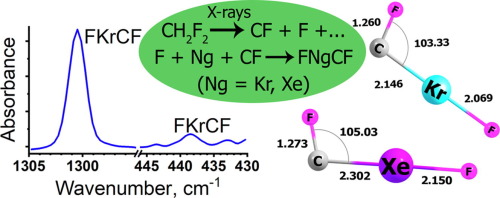
Ilya S.Sosulin, Daniil A.Tyurin, Vladimir I.Feldman
Carbene-insertion noble gas compounds: FKrCF and FXeCF
Chem. Phys. Lett. 2020 744, 137211. DOI: 10.1016/j.cplett.2020.137211
Abstract
FKrCF and FXeCF were synthetized in solid krypton and xenon matrices at cryogenic temperatures. These molecules representing a new class of noble-gas compounds are formed as a result of reaction between mobile F atoms and trapped CF fragment in solid Kr and Xe, which occur after X-ray radiolysis of CH2F2 in the corresponding matrices. The assignment was based on comparison with previously published computational data (Chopra et al., Chem. Phys., 2017, 494, 20) and the results of additional quantum chemical calculations. New molecules were found to be sensitive to near-IR, visible and UV light.
Pavel V Zasimov, Sergey V Ryazantsev, Daniil A Tyurin, Vladimir I Feldman
Radiation-induced chemistry in the C2H2–H2O system at cryogenic temperatures: a matrix isolation study
MN RAS 2020 491, 4, 5140-5150. DOI: 10.1093/mnras/stz3228
Abstract
Investigations of the low-temperature radiation-induced transformations in the C2H2–H2O system are relevant to the chemistry occurring in interstellar and cometary ices. In this work, we applied a matrix isolation technique to study the radiation-driven evolution of this system at molecular level in order to get new mechanistic insight. The 1:1 C2H2⋅ ⋅ ⋅H2O complexes were prepared in various solid noble-gas matrices (Ar, Kr, Xe) and these icy matrices were subjected to X-ray irradiation at 5 K. Decomposition of initial complex and formation of products were monitored by Fourier-transform infrared (FTIR) spectroscopy. It was found that complexation with H2O resulted in significant enhancement of the radiolytic decay of C2H2 molecules and provided new channels for its radiation-induced transformations. Ketene (both isolated H2CCO and in the form of H2CCO–H2 pair), ketenyl radical (HCCO), carbon monoxide (CO), and methane (CH4) were observed as main products of the C2H2⋅ ⋅ ⋅H2O radiolysis. In addition, vinyl alcohol (CH2CHOH) was detected in an Ar matrix. The mechanistic interpretation (reaction routes leading to formation of these products) is discussed on the basis of consideration of kinetic dependences and matrix effects. Conversion of C2H2⋅ ⋅ ⋅H2O to CH4 is a prominent example of water-mediated cleavage of the C≡C triple bond, which may occur under prolonged irradiation in rigid media. Possible astrochemical implications of the obtained results are highlighted.
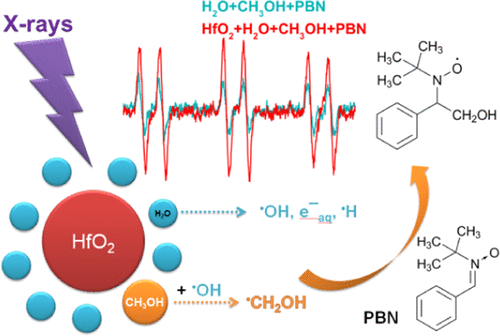
Ekaterina S. Shiryaeva, Irina A. Baranova, Grigorii O. Kiselev, Vladimir N. Morozov, Alexandr V. Belousov, Anastasiia A. Sherstiuk, Maria A. Kolyvanova, Pavel V. Krivoshapkin, Vladimir I. Feldman.
Hafnium Oxide as a Nanoradiosensitizer under X-ray Irradiation of Aqueous Organic Systems: A Model Study Using the Spin-Trapping Technique and Monte Carlo Simulations
J. Phys. Chem. C, 123, 45, 27375–27384, 2019
DOI: 10.1021/acs.jpcc.9b08387
Abstract
The development of the physicochemical basis for applications of nanoradiosensitizers for targeted treatment of tumors is one of the crucial issues of modern radiotherapy. Ceramic nanoparticles (NPs) composed of heavy metal oxides are considered as prospective sensitizers, particularly for X-ray treatment. This study reports a novel approach for experimental simulations of the radiosensitizing effect of NPs in biomimetic systems based on the quantification of radicals produced from organic components in concentrated aqueous organic solutions using the spin-trapping technique with electron paramagnetic resonance detection. This approach was first applied to X-ray irradiation (45 kVp) of aqueous methanol solutions systems containing different concentrations of hafnium oxide nanoparticles with an average diameter of ca. 84 nm (up to 1.8 wp). It was found that the amount of radicals produced from methanol at the same exposition time increased linearly with the increasing content of HfO2 NPs. The effect can be reasonably explained by the physical enhancement mechanism associated with efficient transfer of absorbed energy from the NPs to aqueous organic medium. The Monte Carlo simulations were applied to calculate the absorbed dose in the studied systems as a function of NP concentration. The experimental enhancement factor in the formation of radicals (0.71 wp–1) was found to be slightly lower than the calculated coefficient of the absorbed dose enhancement (0.80 wp–1), which can be explained by partial self-absorption of generated secondary electrons inside rather bulky HfO2 nanoparticles. The proposed model approach may provide a rational ground for comparative studies of different nanoradiosensitizers and the optimization of the NP size, photon energy, and other factors.
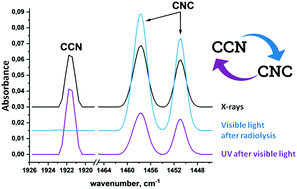
Anastasia D. Volosatova, Svetlana V. Kameneva and Vladimir I. Feldman.
Formation and interconversion of CCN and CNC radicals resulting from the radiation-induced decomposition of acetonitrile in solid noble gas matrices
Phys. Chem. Chem. Phys., 21, 13014-13021, 2019
DOI: 10.1039/C8CP07896C
Abstract
Acetonitrile and the species resulting from its dehydrogenation play an important role in the radiation-induced evolution of organic matter in the space environment. In this work, we report on FTIR spectroscopic studies of the degradation of isolated CH3CN and CD3CN molecules induced by prolonged X-ray irradiation in solid noble gas matrices at 5 K. The principal products observed at high conversion degree of the parent acetonitrile molecules (70–90%) are CCN and CNC radicals, which result from prompt or two-step dehydrogenation of the corresponding precursors, H2CN and CH2NC radicals, respectively. CHCN and CHNC were also found as products of dehydrogenation at high absorbed doses, whereas the fragmentation products (CH3, CN, HCN, and HNC) were detected only in minor amounts over the whole dose range studied. CCN and CNC are produced in nearly equal amounts at high absorbed doses. Selective isomerization of CCN to CNC was observed under the illumination with visible light (460–470 nm), while subsequent action of the UV light (254 nm) induced reverse transformation leading to a photostationary state with the relative population of CNC/CCN being ca. 0.7. The astrochemical implications of the obtained results are discussed in connection with the recent discovery of CCN in extraterrestrial objects.
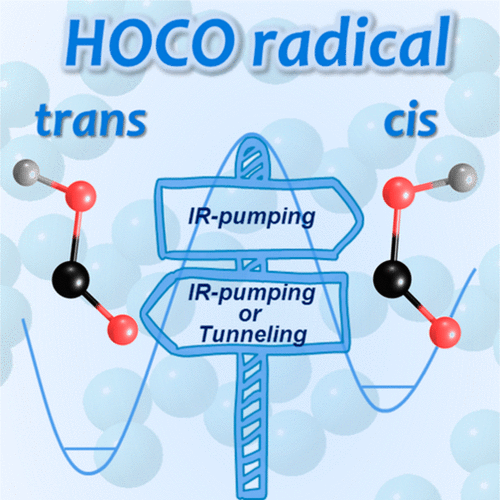
Sergey V. Ryazantsev, Vladimir I. Feldman and Leonid Khriachtchev.
Conformational Switching of HOCO Radical: Selective Vibrational Excitation and Hydrogen-Atom Tunneling
J. Am. Chem. Soc., 139, 28, 9551–9557, 2017
DOI: 10.1021/jacs.7b02605
Abstract
Conformers of carboxyl radical (HOCO) have been studied by IR spectroscopy in argon and nitrogen matrices. In an argon matrix, only the lower-energy conformer trans-HOCO is observed, whereas both cis and trans conformers are found for deuterated carboxyl radical DOCO. In a nitrogen matrix, both conformers of HOCO and DOCO isotopologues can be prepared, indicating strong stabilization of the higher-energy cis conformer by a nitrogen matrix. Selective vibrational excitation promotes the trans-to-cis and cis-to-trans conversions of DOCO in an argon matrix and HOCO and DOCO in a nitrogen matrix, which is the first conformational photoswitching of an open-shell species. In a nitrogen matrix, the cis-to-trans and trans-to-cis conversions of HOCO is also found upon broadband IR light of the spectrometer, and the ratio of the quantum yields of these processes is about 3.3. The photoswitching peculiarities are in agreement with the available theoretical energy barriers. The higher-energy cis conformer decays to the lower-energy trans conformer via hydrogen-atom tunneling through the torsional barrier, which is also a unique observation for an open-shell species. The tunneling mechanism of the cis-to-trans switching is supported by the low-temperature limit of the reaction rate and by the H/D kinetic isotope effect. Our results suggest a large difference in the H/D kinetic isotope effects in nitrogen and argon matrices (∼5 and >100, respectively). The stabilizing effect on cis-DOCO by a nitrogen matrix (by 2 orders of magnitude versus an argon matrix) is much smaller than that on cis-HOCO (estimated to be >104).
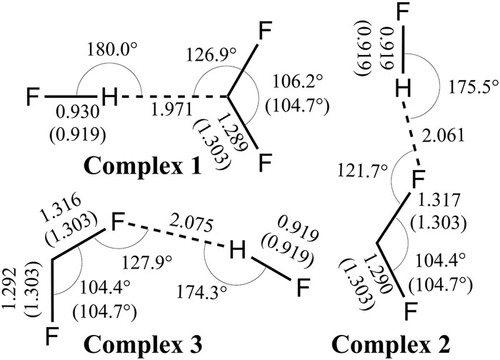
Ilya S. Sosulin, Ekaterina S. Shiryaeva, Daniil A. Tyurin, and Vladimir I. Feldman
Communication: A hydrogen-bonded difluorocarbene complex: Ab initio and matrix isolation study
J. Chem. Phys. 147, 131102, 2017
DOI: 10.1063/1.4999772
Abstract
Structure and spectroscopic features of the CF2⋯HF complexes were studied by ab initio calculations at the CCSD(T) level and matrix isolation FTIR spectroscopy. The calculations predict three stable structures. The most energetically favorable structure corresponds to hydrogen bonding of HF to the lone pair of the C atom (the interaction energy of 3.58 kcal/mol), whereas two less stable structures are the H⋯F bonded complexes (the interaction energies of 0.30 and 0.24 kcal/mol). The former species was unambiguously characterized by the absorptions in the FTIR spectra observed after X-ray irradiation of fluoroform in a xenon matrix at 5 K. The corresponding features appear at 3471 (H–F stretching), 1270 (C–F symmetric stretching, shoulder), 1175 (antisymmetric C–F stretching), and 630 (libration) cm−1, in agreement with the computational predictions. To our knowledge, it is the first hydrogen-bonded complex of dihalocarbene. Possible weaker manifestations of the H⋯F bonded complexes were also found in the C–F stretching region; however, their assignment is tentative. The H⋯C bonded complex is protected from reaction yielding a fluoroform molecule by a remarkably high energy barrier (23.85 kcal/mol), so it may be involved in various chemical reactions.
Complete list of publications since 2001
- Sosulin, I.S., Feldman, V.I. Infrared spectrum of CF2+ cation in a solid argon matrix (2022) Chemical Physics Letters, 807, 140108, DOI: 10.1016/j.cplett.2022.140108
- Sosulin, I.S., Zezin, A.A., Feldman, V.I. Effect of irradiation on poly(acrylic acid)-polyethyleneimine interpolyelectrolyte complexes: An electron paramagnetic resonance study (2022) Radiation Physics and Chemistry, 197, 110198,DOI: 10.1016/j.radphyschem.2022.110198
- Nesterov, S.V., Zakurdaeva, O.A., Sokolova, N.A., Rychkov, P.V., Feldman, V.I. Evidence for effect of macrocycle symmetry on radiation-induced ring opening in 18-crown-6 complexes with alkali-earth metal halogenides (2022) Radiation Physics and Chemistry, 196, 110135, DOI: 10.1016/j.radphyschem.2022.110135
- Volosatova, A.D., Tyurin, D.A., Feldman, V.I. The Radiation Chemistry of NH3···CO Complex in Cryogenic Media as Studied by Matrix Isolation (2022) Journal of Physical Chemistry A, 126 (24), pp. 3893-3902. DOI: 10.1021/acs.jpca.2c01774
- Shiryaeva, E.S., Baranova, I.A., Sanochkina, E.V., Dement’eva, O.V., Kartseva, M.E., Shishmakova, E.M., Rudoy, V.M., Belousov, A.V., Morozov, V.N., Feldman, V.I. On the mechanism of radiation sensitization by gold nanoparticles under X-ray irradiation of oxygen-free aqueous organic solutions: A spin trapping study
- (2022) Radiation Physics and Chemistry, 193, 109998, DOI: 10.1016/j.radphyschem.2022.109998
- Zharikov, A.A., Vinogradov, R.A., Zezina, E.A., Pozdnyakov, A.S., Feldman, V.I., Vasiliev, A.L., Zezin, A.A. The radiation-induced preparation of ultrasmall gold nanoparticles in Au(III) complexes with units of poly(1-vinyl-1,2,4-triazole) and poly(1-vinyl-1,2,4-triazole) – poly(acrylic acid) (2022) Colloids and Interface Science Communications, 47, 100602, DOI: 10.1016/j.colcom.2022.100602
- Sosulin, I.S., Feldman, V.I. Spectroscopy and radiation-induced chemistry of an atmospherically relevant CH2F2…H2O complex: Evidence for the formation of CF2…H2O complex as revealed by FTIR matrix isolation and ab initio study
- (2022) Chemosphere, 291, 132967, DOI: 10.1016/j.chemosphere.2021.132967
Lukianova, M.A., Feldman, V.I. Radiation-induced closure of the second aromatic ring: Possible way to PAH starting from a styrene-acetylene complex // Radiation Physics and Chemistry, 191, 109847. (2022) DOI: 10.1016/j.radphyschem.2021.109847- Zasimov, P.V., Sanochkina, E.V., Feldman, V.I. Radiation-induced transformations of acetaldehyde molecules at cryogenic temperatures: a matrix isolation study // Physical Chemistry Chemical Physics, 24 (1), pp. 419-432. (2022) DOI: 10.1039/d1cp03999g
- Sosulin, I.S., Feldman, V.I. Radiation-induced transformations of difluoromethane in noble gas matrices // Radiation Physics and Chemistry, 189, 109672. (2021) DOI: 10.1016/j.radphyschem.2021.109672
- Volosatova, A.D., Lukianova, M.A., Zasimov, P.V., Feldman, V.I. Direct evidence for a radiation-induced synthesis of acetonitrile and isoacetonitrile from a 1 : 1 CH4⋯HCN complex at cryogenic temperatures: Is it a missing link between inorganic and prebiotic astrochemistry? // Physical Chemistry Chemical Physics, 23 (34), pp. 18449-18460. (2021) DOI: 10.1039/d1cp01598b
- Feldman, V.I., Ryazantsev, S.V., Kameneva, S.V. Matrix isolation in laboratory astrochemistry: State-of-the-art, implications and perspective // Russian Chemical Reviews, 90 (9), pp. 1142-1165. (2021) DOI: 10.1070/RCR4995
- Zasimov, P.V., Ryazantsev, S.V., Tyurin, D.A., Feldman, V.I. C2H2···CO complex and its radiation-induced transformations: A building block for cold synthetic astrochemistry // Monthly Notices of the Royal Astronomical Society, 506 (3), pp. 3499-3510. (2021) DOI: 10.1093/mnras/stab1820
- Lukianova, M.A., Feldman, V.I. Direct evidence for a single-step radiation-induced assembling of benzene ring from acetylene trimer at cryogenic temperatures // Radiation Physics and Chemistry, 183, 109417. (2021) DOI: 10.1016/j.radphyschem.2021.109417
- Sosulin, I.S., Tyurin, D.A., Feldman, V.I. A hydrogen-bonded CHFaHF complex: IR spectra and unusual photochemistry // Journal of Chemical Physics, 154 (10), 0041159. (2021) DOI: 10.1063/5.0041159
- Lukianova, M.A., Volosatova, A.D., Drabkin, V.D., Sosulin, I.S., Kameneva, S.V., Feldman, V.I. Radiation-induced transformations of HCN⋯C2H2, HCN⋯C2H4 and HCN⋯C2H6 complexes in noble gas matrices: Synthesis of C3HxN molecules in cryogenic media // Radiation Physics and Chemistry, 180, 109232. (2021) DOI: 10.1016/j.radphyschem.2020.109232
- Sosulin, I.S., Feldman, V.I. Spectroscopy and radiation-induced chemistry of an atmospherically relevant CH2F2…H2O complex: Evidence for the formation of CF2…H2O complex as revealed by FTIR matrix isolation and ab initio study // Chemosphere, 132967. (2021) DOI: 10.1016/j.chemosphere.2021.132967
- Sosulin, I.S., Tyurin, D.A., Feldman, V.I. A hydrogen-bonded CH2F2⋯CO complex: ab initio and matrix isolation study // Journal of Molecular Structure, 1221, 128784. (2020) DOI: 10.1016/j.molstruc.2020.128784
- Feldman, V.I., Zezin, A. The 13th International Symposium on Ionizing Radiation and Polymers (IRaP, 2018) // Radiation Physics and Chemistry, 177, 109004. (2020) DOI: 10.1016/j.radphyschem.2020.109004
- Zasimov, P.V., Belousov, A.V., Baranova, I.A., Feldman, V.I. Quantitative assessment of the absorbed dose in cryodeposited noble-gas films under X-ray irradiation: Simulation vs. experiment // Radiation Physics and Chemistry, 177, 109084. (2020) DOI: 10.1016/j.radphyschem.2020.109084
- Lukianova, M.A., Sosulin, I.S., Tyurin, D.A., Feldman, V.I. Radiation-induced transformations of isolated toluene molecules in low-temperature matrices: Towards better understanding of molecular radiation chemistry in condensed phases // Radiation Physics and Chemistry, 176, 109022. (2020) DOI: 10.1016/j.radphyschem.2020.109022
- Nesterov, S.V., Zakurdaeva, O.A., Sokolova, N.A., Rychkov, P.V., Feldman, V.I. Radiation-induced macrocycle cleavage in crown ether complexes with Sr(II) and Y(III) chlorides: A comparative study // Radiation Physics and Chemistry, 176, 109023. (2020) DOI: 10.1016/j.radphyschem.2020.109023
- Ryazantsev, S.V., Zasimov, P.V., Feldman, V.I. Radiation-induced synthesis of formic acid in the H2O–CO system: A matrix isolation study // Chemical Physics Letters, 753, 137540. (2020) DOI: 10.1016/j.cplett.2020.137540
- Shiryaeva, E.S., Baranova, I.A., Tyurin, D.A., Feldman, V.I. Reactions of radiation-induced electrons with carbon dioxide in inert cryogenic films: Matrix tuning of the excess electron interactions in solids // Physical Chemistry Chemical Physics, 22 (25), pp. 14155-14161. (2020) DOI: 10.1039/d0cp01578d
- Sosulin, I.S., Tyurin, D.A., Feldman, V.I. Carbene-insertion noble gas compounds: FKrCF and FXeCF // Chemical Physics Letters, 744, 137211. (2020) DOI: 10.1016/j.cplett.2020.137211
- Zezin, A.A., Klimov, D.I., Zezina, E.A., Mkrtchyan, K.V., Feldman, V.I. Controlled radiation-chemical synthesis of metal polymer nanocomposites in the films of interpolyelectrolyte complexes: Principles, prospects and implications // Radiation Physics and Chemistry, 169, 108076. (2020) DOI: 10.1016/j.radphyschem.2018.11.030
- Sosulin, I.S., Tyurin, D.A., Feldman, V.I. Radiation-Induced Transformation of CHF3···CO to the CF3···CO Complex: Matrix Isolation and Ab Initio Study // Journal of Physical Chemistry A, 124 (10), pp. 1954-1958. (2020) DOI: 10.1021/acs.jpca.9b09240
- Zasimov, P.V., Ryazantsev, S.V., Tyurin, D.A., Feldman, V.I. Radiation-induced chemistry in the C2H2–H2O system at cryogenic temperatures: A matrix isolation study // Monthly Notices of the Royal Astronomical Society, 491 (4), pp. 5140-5150. (2020) DOI: 10.1093/mnras/stz3228
- Dağaş, D.E., Danelyan, G.V., Ghaffarlou, M., Zezina, E.A., Abramchuk, S.S., Feldman, V.I., Güven, O., Zezin, A.A. Generation of spatially ordered metal–polymer nanostructures in the irradiated dispersions of poly(acrylic acid)–poly(vinylimidazole)–Cu2+ complexes // Colloid and Polymer Science, 298 (2), pp. 193-202. (2020) DOI: 10.1007/s00396-019-04592-5
- Shiryaeva, E.S., Baranova, I.A., Kiselev, G.O., Morozov, V.N., Belousov, A.V., Sherstiuk, A.A., Kolyvanova, M.A., Krivoshapkin, P.V., Feldman, V.I. Hafnium oxide as a nanoradiosensitizer under x-ray irradiation of aqueous organic systems: A model study using the spin-trapping technique and monte carlo simulations // Journal of Physical Chemistry C, 123 (45), pp. 27375-27384. (2019) DOI: 10.1021/acs.jpcc.9b08387
- Nesterov, S.V., Zakurdaeva, O.A., Sokolova, N.A., Rudakova, T.A., Feldman, V.I. Conformational insight into radiation-chemical transformations of dicyclohexano-18-crown-6 complexes with alkaline earth metal chlorides: Effect of cation size // Radiation Physics and Chemistry, 164, 108368. (2019) DOI: 10.1016/j.radphyschem.2019.108368
- Karganov, M.Y., Alchinova, I.B., Polyakova, M.V., Feldman, V.I., Gorbunov, S.A., Ivanov, O.M., Rymzhanov, R.A., Skuratov, V.A., Volkov, A.E. Stability of dry Phage Lambda DNA irradiated with swift heavy ions // Radiation Physics and Chemistry, 162, pp. 194-198. (2019) DOI: 10.1016/j.radphyschem.2019.04.048
- Klimov, D.I., Zezina, E.A., Lipik, V.С., Abramchuk, S.S., Yaroslavov, A.A., Feldman, V.I., Sybachin, A.V., Spiridonov, V.V., Zezin, A.A. Radiation-induced preparation of metal nanostructures in coatings of interpolyelectrolyte complexes // Radiation Physics and Chemistry, 162, pp. 23-30. (2019) DOI: 10.1016/j.radphyschem.2019.04.027
- Lukianova, M.A., Sanochkina, E.V., Feldman, V.I. Radiation-Induced Transformations of C6H6 Molecules in Solid Noble-Gas Matrices: Is Benzene Intrinsically Resistant in Condensed Media? // Journal of Physical Chemistry A, 123 (25), pp. 5199-5205. (2019) DOI: 10.1021/acs.jpca.9b01137
- Zezina, E.A., Emel’yanov, A.I., Pozdnyakov, A.S., Prozorova, G.F., Abramchuk, S.S., Feldman, V.I., Zezin, A.A. Radiation-induced synthesis of copper nanostructures in the films of interpolymer complexes // Radiation Physics and Chemistry, 158, pp. 115-121. (2019) DOI: 10.1016/j.radphyschem.2019.01.019
- Sosulin, I.S., Tyurin, D.A., Feldman, V.I. CHF 3 …H 2 O complex revisited: a matrix isolation and ab initio study // Structural Chemistry, 30 (2), pp. 559-566. (2019) DOI: 10.1007/s11224-018-1232-z
- Zezin, A.A., Emel’yanov, A.I., Prozorova, G.F., Zezina, E.A., Feldman, V.I., Abramchuk, S.S., Pozdnyakov, A.S. A one-pot radiation-chemical synthesis of metal-polymeric nanohybrides in solutions of vinyltriazole containing gold ions // Mendeleev Communications, 29 (2), pp. 158-159. (2019) DOI: 10.1016/j.mencom.2019.03.013
- Volosatova, A.D., Kameneva, S.V., Feldman, V.I. Formation and interconversion of CCN and CNC radicals resulting from the radiation-induced decomposition of acetonitrile in solid noble gas matrices // Physical Chemistry Chemical Physics, 21 (24), pp. 13014-13021. (2019) DOI: 10.1039/c8cp07896c
- Ryazantsev, S.V., Tyurin, D.A., Nuzhdin, K.B., Feldman, V.I., Khriachtchev, L. The HKrCCH⋯CO2 complex: An: ab initio and matrix-isolation study // Physical Chemistry Chemical Physics, 21 (7), pp. 3656-3661. (2019) DOI: 10.1039/c8cp04327b
- Nesterov, S.V., Zakurdaeva, O.A., Kurkin, T.S., Feldman, V.I. Role of anions in radiation-induced transformations of 18-crown-6 complexes with barium salts: simulating the effects of extraction mechanism on radiation stability of macrocyclic extractants // Journal of Radioanalytical and Nuclear Chemistry, 318 (3), pp. 1901-1911. (2018) DOI: 10.1007/s10967-018-6093-9
- Ryazantsev, S.V., Zasimov, P.V., Feldman, V.I. X-ray radiolysis of C2 hydrocarbons in cryogenic media // Radiation Physics and Chemistry, 151, pp. 253-260. (2018) DOI: 10.1016/j.radphyschem.2018.06.005
- Sosulin, I.S., Shiryaeva, E.S., Tyurin, D.A., Feldman, V.I. Matrix Isolation and Ab Initio Study on the CHF3···CO Complex // Journal of Physical Chemistry A, 122 (16), pp. 4042-4047. (2018) DOI: 10.1021/acs.jpca.8b01485
- Zakurdaeva, O.A., Nesterov, S.V., Sokolova, N.A., Dorovatovskii, P.V., Zubavichus, Y.V., Khrustalev, V.N., Asachenko, A.F., Chesnokov, G.A., Nechaev, M.S., Feldman, V.I. Evidence for Indirect Action of Ionizing Radiation in 18-Crown-6 Complexes with Halogenous Salts of Strontium: Simulation of Radiation-Induced Transformations in Ionic Liquid/Crown Ether Compositions // Journal of Physical Chemistry B, 122 (6), pp. 1992-2000. (2018) DOI: 10.1021/acs.jpcb.7b11498
- Ryazantsev, S.V., Lundell, J., Feldman, V.I., Khriachtchev, L. Photochemistry of the H2O/CO System Revisited: The HXeOH···CO Complex in a Xenon Matrix // Journal of Physical Chemistry A, 122 (1), pp. 159-166. (2018) DOI: 10.1021/acs.jpca.7b10293
- Klimov, D.I., Zezina, E.A., Zezin, S.B., Yang, M., Wang, F., Shvedunov, V.I., Feldman, V.I., Zezin, A.A. Radiation-induced preparation of bimetallic nanoparticles in the films of interpolyelectrolyte complexes // Radiation Physics and Chemistry, 142, pp. 65-69. (2018) DOI: 10.1016/j.radphyschem.2017.02.034
- Ryazantsev, S.V., Tyurin, D.A., Feldman, V.I. Experimental determination of the absolute infrared absorption intensities of formyl radical HCO // Spectrochimica Acta – Part A: Molecular and Biomolecular Spectroscopy, 187, pp. 39-42. (2017) DOI: 10.1016/j.saa.2017.06.018
- Kameneva, S.V., Volosatova, A.D., Feldman, V.I. Radiation-induced transformations of isolated CH3CN molecules in noble gas matrices // Radiation Physics and Chemistry, 141, pp. 363-368. (2017) DOI: 10.1016/j.radphyschem.2017.08.011
- Ryazantsev, S.V., Tyurin, D.A., Feldman, V.I., Khriachtchev, L. Spectroscopic characterization of the complex of vinyl radical and carbon dioxide: Matrix isolation and ab initio study // Journal of Chemical Physics, 147 (18), 184301. (2017) DOI: 10.1063/1.5000578
- Sosulin, I.S., Shiryaeva, E.S., Tyurin, D.A., Feldman, V.I. Communication: A hydrogen-bonded difluorocarbene complex: Ab initio and matrix isolation study // Journal of Chemical Physics, 147 (13), 131102. (2017) DOI: 10.1063/1.4999772
- Sosulin, I.S., Shiryaeva, E.S., Feldman, V.I. Mechanism of the radiation-induced transformations of fluoroform in solid noble gas matrixes // Radiation Physics and Chemistry, 138, pp. 60-66. (2017) DOI: 10.1016/j.radphyschem.2017.03.016
- Ryazantsev, S.V., Feldman, V.I., Khriachtchev, L. Conformational Switching of HOCO Radical: Selective Vibrational Excitation and Hydrogen-Atom Tunneling // Journal of the American Chemical Society, 139 (28), pp. 9551-9557. (2017) DOI: 10.1021/jacs.7b02605
- Ryazantsev, S.V., Tarroni, R., Feldman, V.I., Khriachtchev, L. Effect of Noncovalent Interactions on Vibronic Transitions: An Experimental and Theoretical Study of the C2H⋅⋅⋅CO2 Complex // ChemPhysChem, 18 (8), pp. 949-958. (2017) DOI: 10.1002/cphc.201601441
- Kameneva, S.V., Tyurin, D.A., Feldman, V.I. Characterization of the HCN⋯CO complex and its radiation-induced transformation to HNC⋯CO in cold media: An experimental and theoretical investigation // Physical Chemistry Chemical Physics, 19 (35), pp. 24348-24356. (2017) DOI: 10.1039/c7cp03518g
- Zakurdaeva, O.A., Nesterov, S.V., Feldman, V.I. Stereoisomeric effect in low temperature radiolysis of dicyclohexano-18-crown-6 complexes with BaCl2 // Radiation Physics and Chemistry, 130, pp. 379-384. (2017) DOI: 10.1016/j.radphyschem.2016.09.024
- Kameneva, S.V., Tyurin, D.A., Nuzhdin, K.B., Feldman, V.I. Matrix isolation and ab initio study on HCN/CO2 system and its radiation-induced transformations: Spectroscopic evidence for HCN⋯CO2 and trans-HCNH⋯CO2 complexes // Journal of Chemical Physics, 145 (21), 214309. (2016) DOI: 10.1063/1.4969075
- Shiryaeva, E.S., Tyurin, D.A., Feldman, V.I. Mechanisms of Radiation-Induced Degradation of CFCl3 and CF2Cl2 in Noble-Gas Matrixes: An Evidence for “hot” Ionic Channels in the Solid Phase // Journal of Physical Chemistry A, 120 (40), pp. 7847-7858. (2016) DOI: 10.1021/acs.jpca.6b07301
- Aulov, V.A., Feldman, V.I., Kuchkina, I.O., Ozerin, A.N. Multiplicity of radiothermoluminescence curves of n-tetracosane // High Energy Chemistry, 50 (4), pp. 245-248. (2016) DOI: 10.1134/S0018143916040020
- Saenko, E.V., Lukianova, M.A., Shiryaeva, E.S., Takahashi, K., Feldman, V.I. Radiation-induced intermediates in irradiated glassy ionic liquids at low temperature // Radiation Physics and Chemistry, 124, pp. 26-29. (2016) DOI: 10.1016/j.radphyschem.2015.11.004
- Shiryaeva, E.S., Sosulin, I.S., Saenko, E.V., Feldman, V.I. Ion-radical intermediates of the radiation-chemical transformations of organic carbonates // Radiation Physics and Chemistry, 124, pp. 19-25. (2016) DOI: 10.1016/j.radphyschem.2016.01.010
- Feldman, V.I., Ryazantsev, S.V., Saenko, E.V., Kameneva, S.V., Shiryaeva, E.S. Matrix isolation model studies on the radiation-induced transformations of small molecules of astrochemical and atmospheric interest // Radiation Physics and Chemistry, 124, pp. 7-13. (2016) DOI: 10.1016/j.radphyschem.2015.12.005
- Kameneva, S.V., Tyurin, D.A., Feldman, V.I. Structure and properties of the radiation-induced intermediates produced from HCN in noble gas matrices // Radiation Physics and Chemistry, 124, pp. 30-37. (2016) DOI: 10.1016/j.radphyschem.2015.12.001
- Aulov, V.A., Feldman, V.I., Kuchkina, I.O., Ozerin, A.N. Radiothermoluminescence of n-eicosane mixtures with n-tetracosane: Effect of mixture composition // High Energy Chemistry, 50 (3), pp. 184-188. (2016) DOI: 10.1134/S0018143916030024
- Aulov, V.A., Feldman, V.I., Kuchkina, I.O., Ozerin, A.N. Radiothermoluminescence of linear polyethylene with extended-chain crystals // High Energy Chemistry, 50 (1), pp. 16-20. (2016) DOI: 10.1134/S001814391506003X
- Sosulin, I.S., Shiryaeva, E.S., Feldman, V.I. Radiation-induced radicals in different polymorphic modifications of d-mannitol: Structure, conformations and dosimetric implications // Radiation Physics and Chemistry, 117, pp. 178-183. (2015) DOI: 10.1016/j.radphyschem.2015.08.011
- Ryazantsev, S.V., Feldman, V.I. Radiation-induced transformations of matrix-isolated formic acid: evidence for the HCOOH → HOCO + H channel // Physical Chemistry Chemical Physics, 17 (45), pp. 30648-30658. (2015) DOI: 10.1039/c5cp05446j
- Zakurdaeva, O.A., Nesterov, S.V., Shmakova, N.A., Sokolova, N.A., Feldman, V.I. The low temperature radiolysis of cis-syn-cis-dicyclohexano-18-crown-6 complexes with alkaline earth metal nitrates: An evidence for energy transfer to the macrocyclic ligand // Radiation Physics and Chemistry, 115, pp. 183-188. (2015) DOI: 10.1016/j.radphyschem.2015.07.004
- Saenko, E.V., Laikov, D.N., Feldman, V.I. IR-spectroscopic manifestation of the diacetyl radical anion produced by irradiation of diacetyl in a dimethyl ether matrix at 7 K // Mendeleev Communications, 25 (4), 1139, pp. 267-268. (2015) DOI: 10.1016/j.mencom.2015.07.011
- Zezin, A.A., Feldman, V.I., Abramchuk, S.S., Danelyan, G.V., Dyo, V.V., Plamper, F.A., Müller, A.H.E., Pergushov, D.V. Efficient size control of copper nanoparticles generated in irradiated aqueous solutions of star-shaped polyelectrolyte containers // Physical Chemistry Chemical Physics, 17 (17), pp. 11490-11498. (2015) DOI: 10.1039/c5cp00269a
- Kameneva, S.V., Kobzarenko, A.V., Feldman, V.I. Kinetics and mechanism of the radiation-chemical synthesis of krypton hydrides in solid krypton matrices // Radiation Physics and Chemistry, 110, pp. 17-23. (2015) DOI: 10.1016/j.radphyschem.2015.01.007
- Ryazantsev, S.V., Feldman, V.I. Matrix-isolation studies on the radiation-induced chemistry in H2O/CO2 systems: Reactions of oxygen atoms and formation of HOCO radical // Journal of Physical Chemistry A, 119 (11), pp. 2578-2586. (2015) DOI: 10.1021/jp509313n
- Feldman, V.I. EPR and IR spectroscopy of free radicals and radical ions produced by radiation in solid systems // Applications of EPR in Radiation Research, 9783319092164, pp. 151-187. (2014) DOI: 10.1007/978-3-319-09216-4_5
- Aulov, V.A., Feldman, V.I., Kuchkina, I.O., Ozerin, A.N. Radiothermoluminescence of surface layers of n-tetracosane crystals // High Energy Chemistry, 48 (4), pp. 244-247. (2014) DOI: 10.1134/S001814391404002X
- Aulov, V.A., Feldman, V.I., Kuchkina, I.O., Ozerin, A.N. Changes in the radiothermoluminescence curve of crystalline regions of polyethylene during storage of its irradiated samples in liquid nitrogen // High Energy Chemistry, 48 (1), pp. 17-23. (2014) DOI: 10.1134/S0018143914010020
- Feldman, V.I. Structure and reactions of aliphatic bridged bifunctional radical ions: Exploring fine-tuning in radiation chemistry // Israel Journal of Chemistry, 54 (3), pp. 284-291. (2014) DOI: 10.1002/ijch.201300122
- Bakar, A., Güven, O., Zezin, A.A., Feldman, V.I. Controlling the size and distribution of copper nanoparticles in double and triple polymer metal complexes by X-ray irradiation // Radiation Physics and Chemistry, 94 (1), pp. 62-65. (2014) DOI: 10.1016/j.radphyschem.2013.07.006
- Ryazantsev, S.V., Kobzarenko, A.V., Feldman, V.I. Photolabile xenon hydrides: A case study of HXeSH and HXeH // Journal of Chemical Physics, 139 (12), 124315. (2013) DOI: 10.1063/1.4822102
- Saenko, E.V., Takahashi, K., Feldman, V.I. EPR evidence for a physically trapped excess electron in a glassy ionic liquid // Journal of Physical Chemistry Letters, 4 (17), pp. 2896-2899. (2013) DOI: 10.1021/jz401292e
- Zakurdaeva, O.A., Nesterov, S.V., Feldman, V.I. Localization of radiation damages in X-rays irradiated cis-syn-cis-dicyclohexano-18-crown-6 and its inclusion complex with BaCl2 // Radiation Physics and Chemistry, 87, pp. 40-45. (2013) DOI: 10.1016/j.radphyschem.2013.02.006
- Feldman, V.I., Zezin, A.A., Abramchuk, S.S., Zezina, E.A. X-ray induced formation of metal nanoparticles from interpolyelectrolyte complexes with copper and silver ions: The radiation-chemical contrast // Journal of Physical Chemistry C, 117 (14), pp. 7286-7293. (2013) DOI: 10.1021/jp3090765
- Saenko, E.V., Laikov, D.N., Feldman, V.I. Reactions of excess electrons with “bridged” amidoesters in low-temperature matrices // Radiation Physics and Chemistry, 85, pp. 147-151. (2013) DOI: 10.1016/j.radphyschem.2012.12.003
- Zakurdaeva, O.A., Nesterov, S.V., Feldman, V.I. Radical intermediates of low temperature radiolysis of di-tert- butylcyclohexano-18-crown-6/1-octanol extractant // Radiochimica Acta, 101 (1), pp. 51-56. (2013) DOI: 10.1524/ract.2013.1993
- Kobzarenko, A.V., Sukhov, F.F., Orlov, A., Kovalev, G.V., Baranova, I.A., Feldman, V.I. Effect of molecular structure on fragmentation of isolated organic molecules in solid rare gas matrices // Radiation Physics and Chemistry, 81 (9), pp. 1434-1439. (2012) DOI: 10.1016/j.radphyschem.2012.01.004
- Feldman, V.I., Kobzarenko, A.V., Orlov, A.Y., Sukhov, F.F. The radiation-induced chemistry in solid xenon matrices // Low Temperature Physics, 38 (8), pp. 766-773. (2012) DOI: 10.1063/1.4743498
- Bakar, A., De, V.V., Zezin, A.A., Abramchuk, S.S., Güven, O., Feldman, V.I. Spatial organization of a metal-polymer nanocomposite obtained by the radiation-induced reduction of copper ions in the poly(Allylamine)-poly(Acrylic Acid)-Cu 2+ system // Mendeleev Communications, 22 (4), pp. 211-212. (2012) DOI: 10.1016/j.mencom.2012.06.014
- Sorokin, I.D., Melnikova, O.L., Pergushov, V.I., Tyurin, D.A., Feldman, V.I., Melnikov, M.Ya. Phototransformations of methylsubstituted oxiranes’ radical cations 1 // High Energy Chemistry, 46 (3), pp. 183-193. (2012) DOI: 10.1134/S0018143912030125
- Sorokin, I.D., Melnikova, O.L., Pergushov, V.I., Tyurin, D.A., Feldman, V.I., Melnikov, M.Y. Phototransformations of methylsubstituted oxiranes’ radical cations in freonic matrices at 77 K // Moscow University Chemistry Bulletin, 67 (2), pp. 59-71. (2012) DOI: 10.3103/S0027131412020071
- Shiryaeva, E.S., Tyurin, D.A., Feldman, V.I. The structure and photochemical transformation of cyclopropylacetylene radical cation as revealed by matrix EPR and quantum chemical study // Chemical Physics Letters, 536, pp. 68-71. (2012) DOI: 10.1016/j.cplett.2012.03.096
- Saenko, E.V., Laikov, D.N., Baranova, I.A., Feldman, V.I. Communication: Stabilization of radical anions with weakly bound electron in condensed media: A case study of diacetonyl radical anion // Journal of Chemical Physics, 135 (10), 101103. (2011) DOI: 10.1063/1.3638690
- Zezin, A.A., Feldman, V.I., Abramchuk, S.S., Ivanchenko, V.K., Zezina, E.A., Shmakova, N.A., Shvedunov, V.I. Formation of metal-polymer hybrid nanostructures during radiation-induced reduction of metal ions in poly(acrylic acid)-poly(ethylenimine) complexes // Polymer Science – Series C, 53 (1), pp. 61-67. (2011) DOI: 10.1134/S1811238211060038
- Feldman, V.I., Baranova, I.A., Kobzarenko, A.V., Tyulpina, I.V. Fragmentation of the primary radical cations of methoxyacetone and acetonylacetone in a solid argon matrix // High Energy Chemistry, 45 (4), pp. 351-352. (2011) DOI: 10.1134/S0018143911040060
- Sorokin, I.D., Feldman, V.I., Mel’nikova, O.L., Pergushov, V.I., Tyurin, D.A., Mel’nikov, M.Ya. Reversible photochemical transformations of cis- and trans-2,3- dimethyloxirane radical cations in freonic matrices at 77 K // Mendeleev Communications, 21 (3), pp. 153-154. (2011) DOI: 10.1016/j.mencom.2011.04.014
- Sorokin, I.D., Feldman, V.I., Mel’nikova, O.L., Pergushov, V.I., Tyurin, D.A., Mel’nikov, M.Ya. The nature and photochemistry of 2,2-dimethyloxirane radical cations in freonic matrices at 77 K // Mendeleev Communications, 21 (3), pp. 155-156. (2011) DOI: 10.1016/j.mencom.2011.04.015
- Zezin, A.A., Feldman, V.I., Zezina, E.A., Belopushkin, S.I., Tsybina, E.V., Abramchuk, S.S., Zezin, S.B. The formation of metal nanoparticles in polyacrylic acid-polyethyleneimine complex upon reduction of copper(II) ions using X-ray irradiation // High Energy Chemistry, 45 (2), pp. 99-103. (2011) DOI: 10.1134/S0018143911020147
- Saenko, V.S., Feldman, V.I., Tyutnev, A.P., Ikhsanov, R.Sh., Nereto, M.O., Baranova, I.A. The role of stable free radicals in the radiation-induced conductivity of low-density polyethylene // High Energy Chemistry, 45 (1), pp. 48-51. (2011) DOI: 10.1134/S0018143911010152
- Zakurdaeva, O.A., Nesterov, S.V., Feldman, V.I. Radiolysis of aqueous solutions of poly(vinyl alcohol) at 77K // Radiation Physics and Chemistry, 79 (8), pp. 876-879. (2010) DOI: 10.1016/j.radphyschem.2010.03.010
- Zezin, A.B., Rogacheva, V.B., Feldman, V.I., Afanasiev, P., Zezin, A.A. From triple interpolyelectrolyte-metal complexes to polymer-metal nanocomposites // Advances in Colloid and Interface Science, 158 (1-2), pp. 84-93. (2010) DOI: 10.1016/j.cis.2009.09.002
- Tyurin, D.A., Shiryaeva, E.S., Feldman, V.I. Structure and photochemical rearrangement of the 3,3-dimethylbut-1-yne radical cation // Mendeleev Communications, 20 (4), pp. 205-206. (2010) DOI: 10.1016/j.mencom.2010.06.007
- Zakurdaeva, O.A., Nesterov, S.V., Feldman, V.I. An ESR study of radiation-chemical transformation of 4,4′(5′)- di-(tert-butylcyclohexano)-18-crown-6 and its solution in 1-octanol at 77 K // Journal of Radioanalytical and Nuclear Chemistry, 284 (3), pp. 641-645. (2010) DOI: 10.1007/s10967-010-0529-1
- Domanskaya, A., Kobzarenko, A.V., Tsivion, E., Khriachtchev, L., Feldman, V.I., Benny Gerber, R., Räsänen, M. Matrix-isolation and ab initio study of HXeCCH complexed with acetylene // Chemical Physics Letters, 481 (1-3), pp. 83-87. (2009) DOI: 10.1016/j.cplett.2009.09.072
- Feldman, V.I., Kobzarenko, A.V., Baranova, I.A., Danchenko, A.V., Sukhov, F.F., Tsivion, E., Gerber, R.B. Direct visualization of the H-Xe bond in xenon hydrides: Xenon isotopic shift in the IR spectra // Journal of Chemical Physics, 131 (15), 151101. (2009) DOI: 10.1063/1.3250426
- Kabanov, V.Y., Feldman, V.I., Ershov, B.G., Polikarpov, A.I., Kiryukhin, D.P., Apel, P.Y. Erratum to: Radiation chemistry of polymers (High Energy Chemistry, (2009), 43, 1, (1), DOI: 10.1134/S0018143909050166) // High Energy Chemistry, 43 (5), pp. 425-425. (2009) DOI: 10.1134/S0018143909050166
- Nuzhdin, K.B., Kobzarenko, A.V., Barabanov, I.I., Feldman, V.I. A ‘magic bridge’: effect of methylene chain length on the photochemistry of radical cations produced from bifunctional X-(CH2)n-Y molecules // Mendeleev Communications, 19 (5), pp. 268-269. (2009) DOI: 10.1016/j.mencom.2009.09.012
- Zezin, A.A., Feldman, V.I., Dudnikov, A.V., Zezin, S.B., Abramchuk, S.S., Belopushkin, S.I. Reduction of copper(II) ions in polyacrylic acid-polyethyleneimine complexes using X-ray radiation // High Energy Chemistry, 43 (2), pp. 100-104. (2009) DOI: 10.1134/S0018143909020064
- Kabanov, V.Ya., Feldman, V.I., Ershov, B.G., Polikarpov, A.I., Kiryukhin, D.P., Apel’, P.Yu. Radiation chemistry of polymers // High Energy Chemistry, 43 (1), pp. 1-18. (2009) DOI: 10.1134/S0018143909010019
- Zakurdaeva, O.A., Nesterov, S.V., Feldman, V.I. Radiolysis of aqueous DCH18C6 solutions at 77 K // Journal of Radioanalytical and Nuclear Chemistry, 279 (2), pp. 647-653. (2009) DOI: 10.1007/s10967-008-7345-x
- Feldman, V.I., Sukhov, F.F., Orlov, A.Y. Hydrogen atoms in solid xenon: Trapping site structure, distribution, and stability as revealed by EPR studies in monoisotopic and isotopically enriched xenon matrices // Journal of Chemical Physics, 128 (21), 214511. (2008) DOI: 10.1063/1.2933366
- Maksimenko, O., Pavlov, E., Toushov, E., Molin, A., Stukalov, Y., Prudskova, T., Feldman, V., Kreuter, J., Gelperina, S. Radiation sterilisation of doxorubicin bound to poly(butyl cyanoacrylate) nanoparticles // International Journal of Pharmaceutics, 356 (1-2), pp. 325-332. (2008) DOI: 10.1016/j.ijpharm.2008.01.010
- Feldman, V.I., Sukhov, F.F., Orlov, A.Yu., Tyulpina, I.V. High-resolution EPR spectroscopy of small radicals in a solid 136Xe matrix // Mendeleev Communications, 18 (3), pp. 121-122. (2008) DOI: 10.1016/j.mencom.2008.05.002
- Nuzhdin, K.B., Feldman, V.I. Structure and photochemistry of “bridged” bifunctional radical cations: Amidoesters vs. amides // Radiation Physics and Chemistry, 77 (4), pp. 416-427. (2008) DOI: 10.1016/j.radphyschem.2007.06.002
- Nuzhdin, K.B., Feldman, V.I., Kobzarenko, A.V. Delocalized methoxyacetone radical cation: structure and reactivity // Mendeleev Communications, 18 (2), pp. 69-70. (2008) DOI: 10.1016/j.mencom.2008.03.003
- Zakurdaeva, O.A., Nesterov, S.V., Shmakova, N.A., Feldman, V.I. Radiation-chemical synthesis of crown-containing poly(ethylene oxide) hydrogels. Swelling behavior and crown ether retention // Radiation Physics and Chemistry, 77 (1), pp. 23-28. (2008) DOI: 10.1016/j.radphyschem.2007.01.010
- Zezin, A.A., Feldman, V.I., Shmakova, N.A., Valueva, S.P., Ivanchenko, V.K., Nikanorova, N.I. The peculiarities of formation of the metal nanoparticles in irradiated polymer metal complexes // Nuclear Instruments and Methods in Physics Research, Section B: Beam Interactions with Materials and Atoms, 265 (1), pp. 334-338. (2007) DOI: 10.1016/j.nimb.2007.08.068
- Zakurdaeva, O.A., Nesterov, S.V., Shmakova, N.A., Semenova, G.K., Sozontova, E.O., Feldman, V.I. Radiation-chemical synthesis of poly(vinyl alcohol) hydrogel containing dicyclohexano-18-crown-6 // Nuclear Instruments and Methods in Physics Research, Section B: Beam Interactions with Materials and Atoms, 265 (1), pp. 356-361. (2007) DOI: 10.1016/j.nimb.2007.09.003
- Egorov, A.V., Baranova, I.A., Zezin, A.A., Andriyanova, A.A., Feldman, V.I. Positive hole transfer between organic molecules of different classes in freon matrices // High Energy Chemistry, 41 (6), pp. 409-414. (2007) DOI: 10.1134/S0018143907060045
- Nuzhdin, K.B., Feldman, V.I., Kobzarenko, A.V. Diketone radical cations: Ketonic and enolic forms as revealed by matrix EPR studies and DFT calculations // Journal of Physical Chemistry A, 111 (17), pp. 3294-3301. (2007) DOI: 10.1021/jp0685380
- Feldman, V.I., Sukhov, F.F., Logacheva, E.A., Orlov, A.Yu., Tyulpina, I.V., Tyurin, D.A. Reactions of H atoms produced by electron irradiation of benzene in solid xenon: IR spectrum of cylohexadienyl radical and possible involvement of HXeC6H5 // Chemical Physics Letters, 437 (4-6), pp. 207-211. (2007) DOI: 10.1016/j.cplett.2007.02.039
- Zakurdaeva, O.A., Nesterov, S.V., Feldman, V.I. Radical products of γ-radiolysis of 12-crown-4 at 77 K // High Energy Chemistry, 41 (2), pp. 65-70. (2007) DOI: 10.1134/S0018143907020038
- Feldman, V.I., Sukhov, F.F., Orlov, A.Yu., Tyulpina, I.V., Ivanchenko, V.K. Stabilization and isomerization of radical cations generated by fast electron irradiation of unsaturated organic molecules in a solid argon matrix // Radiation Physics and Chemistry, 75 (1), pp. 106-114. (2006) DOI: 10.1016/j.radphyschem.2005.03.012
- Tanskanen, H., Khriachtchev, L., Räsänen, M., Feldman, V.I., Sukhov, F.F., Orlov, A.Yu., Tyurin, D.A. Infrared absorption and electron paramagnetic resonance studies of vinyl radical in noble-gas matrices // Journal of Chemical Physics, 123 (6), 064318. (2005) DOI: 10.1063/1.2000907
- Nuzhdin, K.B., Nesterov, S.V., Tyurin, D.A., Feldman, V.I., Liu, W., Lund, A. Structure of radical cations of saturated heterocyclic compounds with two heteroatoms as studied by electron paramagnetic resonance, electron-nuclear double resonance, and density functional theory calculations // Journal of Physical Chemistry A, 109 (28), pp. 6166-6173. (2005) DOI: 10.1021/jp051440l
- Zakurdaeva, O.A., Nesterov, S.V., Feldman, V.I. Radiolysis of aqueous solutions of poly(ethylene oxide) at 77 K // High Energy Chemistry, 39 (4), pp. 201-206. (2005) DOI: 10.1007/s10733-005-0042-1
- Feldman, V.I., Sukhov, F.F., Orlov, A.Yu., Tyul’pina, I.V., Logacheva, E.A., Tyurin, D.A. Chemical reactions in the xenon-acetylene systems irradiated with fast electrons at 16 K: Formation of xenon-containing molecules and radicals // Russian Chemical Bulletin, 54 (6), pp. 1458-1466. (2005) DOI: 10.1007/s11172-005-0427-9
- Belevskii, V.N., Feldman, V.I., Tyurin, D.A. Experimental and theoretical study on the structure and reactions of 1-methoxypropane radical cations // High Energy Chemistry, 39 (2), pp. 77-85. (2005) DOI: 10.1007/s10733-005-0017-2
- Zakurdaeva, O.A., Nesterov, S.V., Feldman, V.I. Radiation chemical synthesis of polyethylene oxide hydrogel containing DCH18C6 crown ether: A new approach // Journal of Radioanalytical and Nuclear Chemistry, 261 (2), pp. 245-248. (2004) DOI: 10.1023/B:JRNC.0000034854.60892.d4
- Zezin, A.A., Feldman, V.I., Warman, J.M., Wildeman, J., Hadziioannou, G. EPR study of positive holes on phenylene vinylene chains: From dimer to polymer // Chemical Physics Letters, 389 (1-3), pp. 108-112. (2004) DOI: 10.1016/j.cplett.2004.03.071
- Feldman, V.I. State of the art and prospects for the future of radiation chemistry research as highlighted by international conferences in 1998-2002 // High Energy Chemistry, 37 (6), pp. 428-433. (2003) DOI: 10.1023/B:HIEC.0000003406.37475.6d
- Egorov, A.V., Zezin, A.A., Feldman, V.I. An EPR study of positive hole transfer and trapping in irradiated frozen solutions containing aromatic traps // Radiation Physics and Chemistry, 67 (3-4), pp. 231-235. (2003) DOI: 10.1016/S0969-806X(03)00042-2
- Feldman, V., Sukhov, F., Orlov, A., Tyulpina, I. Stabilisation and reactions of aliphatic radical cations produced by fast electron irradiation in solid argon matrices // Physical Chemistry Chemical Physics, 5 (9), pp. 1769-1774. (2003) DOI: 10.1039/b300111c
- Feldman, V.I., Sukhov, F.F., Orlov, A.Yu., Tyulpina, I.V. Experimental evidence for the formation of HXeCCH: The first hydrocarbon with an inserted rare-gas atom // Journal of the American Chemical Society, 125 (16), pp. 4698-4699. (2003) DOI: 10.1021/ja034585j
- Mel’nikov, M.Ya., Baskakov, D.V., Feldman, V.I. Spectral characteristics and transformations of intermediates in irradiated Freon 11, Freon 113, and Freon 113a // High Energy Chemistry, 36 (5), pp. 309-315. (2002) DOI: 10.1023/A:1020290432120
- Khriachtchev, L., Tanskanen, H., Pettersson, M., Räsänen, M., Feldman, V., Sukhov, F., Orlov, A., Shestakov, A.F. Isotopic effect on thermal mobility of atomic hydrogen in solid xenon // Journal of Chemical Physics, 116 (13), pp. 5708-5716. (2002) DOI: 10.1063/1.1458549
- Khriachtchev, L., Tanskanen, H., Pettersson, M., Räsänen, M., Ahokas, J., Kunttu, H., Feldman, V. On photochemistry of water in solid Xe: Thermal and light-induced decomposition of HXeOH and HXeH and formation of H2O2 // Journal of Chemical Physics, 116 (13), pp. 5649-5656. (2002) DOI: 10.1063/1.1452725
- Mel’nikov, M.Ya., Baskakov, D.V., Mel’nikova, O.L., Feldman, V.I. Photochemistry of 1,3-dioxolane radical cations in sulfur hexafluoride and freonic matrices at 77 K // High Energy Chemistry, 36 (2), pp. 103-111. (2002) DOI: 10.1023/A:1014615113617
- Knolle, W., Feldman, V.I., Janovský, I., Naumov, S., Mehnert, R., Langguth, H., Sukhov, F.F., Orlov, A.Y. EPR study of methyl and ethyl acrylate radical cations and their transformations in low-temperature matrices // Journal of the Chemical Society. Perkin Transactions 2, 2 (3), pp. 687-699. (2002) DOI: 10.1039/b105384c
- Zezin, A.A., Feldman, V.I. Formation and reactions of paramagnetic species in irradiated microheterogeneous copolymer systems with different electronic characteristics of components // Radiation Physics and Chemistry, 63 (1), pp. 75-80. (2002) DOI: 10.1016/S0969-806X(01)00485-6
- Shmakova, N.A., Feldman, V.I., Sukhov, F.F. IR spectroscopic study of chemical transformations upon irradiation of the poly(vinyl chloride)-triallyl cyanurate system // High Energy Chemistry, 35 (4), pp. 224-228. (2001) DOI: 10.1023/A:1017628410368
- Parshutkina, A.A., Feldman, V.I. IR spectroscopic study of the intermediate products of low-temperature radiolysis of sulfur hexafluoride // High Energy Chemistry, 35 (3), pp. 204-206. (2001) DOI: 10.1023/A:1017524430278
- Feldman, V.I., Sukhov, F.F., Orlov, A.Yu., Shmakova, N.A. Radiation chemistry of organic molecules in solid rare gas matrices: 2. Selective deprotonation of the primary radical cations upon irradiation of oxygen-containing molecules in xenon matrices // High Energy Chemistry, 35 (5), pp. 319-327. (2001) DOI: 10.1023/A:1011978921902
